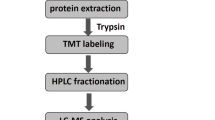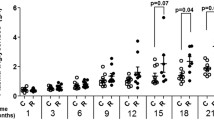Abstract
Hepatic transcriptome and proteome responses against glutathione depletion were investigated by Affymetrix GeneChip Microarray and 2-dimensional gel electrophoresis (2D-DIGE), followed by MALDI-TOF–MS analysis and utilizing a glutathione-depleted rat model treated with diethyl maleate (DEM). Hepatic glutathione content decreased to 1.29 μmol/g liver (25.5% compared to control) after DEM treatment, and there were no apparent hepatotoxic signs estimated by blood chemistry examinations. A total of 247 and 213 annotated gene probe sets exhibited greater than twofold up- and down-regulation compared with controls, respectively. The up-regulated gene list contained a number of glutathione depletion–responsive genes reported previously, such as Trib3, Srxn1, Myc, Asns, Igfbp1, Txnrd1, or Hmox1, suggesting that these genes are robust mRNA biomarkers for evaluating hepatic glutathione depletion. In the 2D-DIGE analysis, proteins for a total of 361 spots were identified by MALDI-TOF–MS analysis. Of the identified proteins, 5 and 14 proteins showed up- and down-regulation, respectively. Some proteins exhibited differential expression in the protein level but not in the mRNA level, including L-FABP, MAWDBP, aldo–keto reductase family 1 member A1, catalase and ATP synthase subunit beta, suggesting that these proteins would be potential protein biomarkers for evaluating glutathione depletion. Moreover, up-regulation of FABP1 protein along with up-regulation of PPARα-regulated gene transcripts (i.e., Acot2 and Acot4) is indicative of PPARα activation, which may contribute to hepatocellular protection against glutathione depletion–induced oxidative stress. The up-regulation of L-FABP1 was detected by proteome data but not by transcriptome data, demonstrating the advantage of utilizing transcriptomics and proteomics combination to investigate glutathione depletion–induced molecular dynamics.







Similar content being viewed by others
References
Binas B, Erol E (2007) FABPs as determinants of myocellular and hepatic fuel metabolism. Mol Cell Biochem 299:75–84
Boyland E, Chasseaud LF (1967) Enzyme-catalysed conjugations of glutathione with unsaturated compounds. Biochem J 104:95–102
Burnett DA, Lysenko N, Manning JA, Ockner RK (1979) Utilization of long chain fatty acids by rat liver: studies of the role of fatty acid binding protein. Gastroenterology 77:241–249
Chanson A, Sayd T, Rock E, Chambon C, Sante-Lhoutellier V, Potier de Courcy G, Brachet P (2005) Proteomic analysis reveals changes in the liver protein pattern of rats exposed to dietary folate deficiency. J Nutr 135:2524–2529
Chen C, Hennig GE, Whiteley HE, Corton JC, Manautou JE (2000) Peroxisome proliferator- activated receptor alpha-null mice lack resistance to acetaminophen hepatotoxicity following clofibrate exposure. Toxicol Sci 57:338–344
Deneke SM, Lynch BA, Fanburg BL (1985) Transient depletion of lung glutathione by diethylmaleate enhances oxygen toxicity. J Appl Physiol 58:571–574
Ellinger-Ziegelbauer H, Gmuender H, Bandenburg A, Ahr HJ (2008) Prediction of a carcinogenic potential of rat hepatocarcinogens using toxicogenomics analysis of short-term in vivo studies. Mutat Res 637:23–39
Fernandez-Checa JC, Garcia-Ruiz C, Ookhtens M, Kaplowitz N (1991) Impaired uptake of glutathione by hepatic mitochondria from chronic ethanol-fed rats. Tracer kinetic studies in vitro and in vivo and susceptibility to oxidant stress. J Clin Invest 87:397–405
Fountoulakis M, Berndt P, Boelsterli UA, Crameri F, Winter M, Albertini S, Suter L (2000) Two- dimensional database of mouse liver proteins: changes in hepatic protein levels following treatment with acetaminophen or its nontoxic regioisomer 3-acetamidophenol. Electrophoresis 21:2148–2161
Gao W, Mizukawa Y, Nakatsu N, Minowa Y, Yamada H, Ohno Y, Urushidani T (2010) Mechanism-based biomarker gene sets for glutathione depletion-related hepatotoxicity in rats. Toxicol Appl Pharmacol 247:211–221
Griffith OW, Meister A (1979) Potent and specific inhibition of glutathione synthesis by buthionine sulfoximine (S-n-butyl homocysteine sulfoximine). J Biol Chem 254:7558–7560
Heijne WH, Stierum RH, Slijper M, van Bladeren PJ, van Ommen B (2003) Toxicogenomics of bromobenzene hepatotoxicity: a combined transcriptomics and proteomics approach. Biochem Pharmacol 65:857–875
Hunt MC, Alexson SE (2002) The role Acyl-CoA thioesterases play in mediating intracellular lipid metabolism. Prog Lipid Res 41:99–130
Iriyama C, Matsuda S, Katsumata R, Hamaguchi M (2001) Cloning and sequencing of a novel human gene which encodes a putative hydroxylase. J Hum Genet 46:289–292
James LP, Mayeux PR, Hinson JA (2003) Acetaminophen-induced hepatotoxicity. Drug Metab Dispos 31:1499–1506
Jansen R, Yu H, Greenbaum D, Kluger Y, Krogan NJ, Chung S, Emili A, Snyder M, Greenblatt JF, Gerstein M (2003) A Bayesian networks approach for predicting protein-protein interactions from genomic data. Science 302:449–453
Jung YS, Kim SJ, Kwon DY, Kim YC (2008) Comparison of the effects of buthioninesulfoximine and phorone on the metabolism of sulfur-containing amino acids in rat liver. Biochem Biophys Res Commun 368:913–918
Kaplowitz N (2005) Idiosyncratic drug hepatotoxicity. Nat Rev Drug Discov 4:489–499
Kim SW, Hwang HJ, Baek YM, Lee SH, Hwang HS, Yun JW (2008) Proteomic and transcriptomic analysis for streptozotocin-induced diabetic rat pancreas in response to fungal polysaccharide treatments. Proteomics 8:2344–2361
Kiyosawa N, Ito K, Sakuma K, Niino N, Kanbori M, Yamoto T, Manabe S, Matsunuma N (2004) Evaluation of glutathione deficiency in rat livers by microarray analysis. Biochem Pharmacol 68:1465–1475
Kiyosawa N, Uehara T, Gao W, Omura K, Hirode M, Shimizu T, Mizukawa Y, Ono A, Miyagishima T, Nagao T, Urushidani T (2007) Identification of glutathione depletion-responsive genes using phorone-treated rat liver. J Toxicol Sci 32:469–486
Kiyosawa N, Ando Y, Manabe S, Yamoto T (2009) Toxicogenomic biomarkers for liver toxicity. J Toxicol Pathol 22:35–52
Linding R, Jensen LJ, Ostheimer GJ, van Vugt MA, Jorgensen C, Miron IM, Diella F, Colwill K, Taylor L, Elder K, Metalnikov P, Nguyen V, Pasculescu A, Jin J, Park JG, Samson LD, Woodgett JR, Russell RB, Bork P, Yaffe MB, Pawson T (2007) Systematic discovery of in vivo phosphorylation networks. Cell 129:1415–1426
Lu SC (1999) Regulation of hepatic glutathione synthesis: current concepts and controversies. FASEB J 13:1169–1183
Matsuda S, Katsumata R, Okuda T, Yamamoto T, Miyazaki K, Senga T, Machida K, Thant AA, Nakatsugawa S, Hamaguchi M (2000) Molecular cloning and characterization of human MAWD, a novel protein containing WD-40 repeats frequently overexpressed in breast cancer. Cancer Res 60:13–17
Mitchell JR, Jollow DJ, Potter WZ, Gillette JR, Brodie BB (1973) Acetaminophen-induced hepatic necrosis. IV. Protective role of glutathione. J Pharmacol Exp Ther 187:211–217
Moon KH, Abdelmegeed MA, Song BJ (2007) Inactivation of cytosolic aldehyde dehydrogenase via S-nitrosylation in ethanol-exposed rat liver. FEBS Lett 581:3967–3972
Papa S, Zanotti F, Gaballo A (2000) The structural and functional connection between the catalytic and proton translocating sectors of the mitochondrial F1F0-ATP synthase. J Bioenerg Biomembr 32:401–411
Sawada H, Takami K, Asahi S (2005) A toxicogenomic approach to drug-induced phospholipidosis: analysis of its induction mechanism and establishment of a novel in vitro screening system. Toxicol Sci 83:282–292
Shi L, Wang Y, Tu S, Li X, Sun M, Srivastava S, Xu N, Bhatnagar A, Liu S (2008) The responses of mitochondrial proteome in rat liver to the consumption of moderate ethanol: the possible roles of aldo-keto reductases. J Proteome Res 7:3137–3145
Soga T, Baran R, Suematsu M, Ueno Y, Ikeda S, Sakurakawa T, Kakazu Y, Ishikawa T, Robert M, Nishioka T, Tomita M (2006) Differential metabolomics reveals ophthalmic acid as an oxidative stress biomarker indicating hepatic glutathione consumption. J Biol Chem 281:16768–16776
Tu S, Ren Y, Tong W, Zheng S, Xu N, Bhatnagar A, Liu S (2009) A new approach to monitor expression of aldo-keto reductase proteins in mouse tissues. Proteomics 9:5090–5100
Uehara T, Hirode M, Ono A, Kiyosawa N, Omura K, Shimizu T, Mizukawa Y, Miyagishima T, Nagao T, Urushidani T (2008) A toxicogenomics approach for early assessment of potential non-genotoxic hepatocarcinogenicity of chemicals in rats. Toxicology 250:15–26
van Doorn R, Leijdekkers CM, Henderson PT (1978) Synergistic effects of phorone on the hepatotoxicity of bromobenzene and paracetamol in mice. Toxicology 11:225–233
Wang G, Gong Y, Anderson J, Sun D, Minuk G, Roberts MS, Burczynski FJ (2005) Antioxidative function of L-FABP in L-FABP stably transfected Chang liver cells. Hepatology 42:871–879
Weber CA, Duncan CA, Lyons MJ, Jenkinson SG (1990) Depletion of tissue glutathione with diethyl maleate enhances hyperbaric oxygen toxicity. Am J Physiol 258:L308–L312
Westin MA, Hunt MC, Alexson SE (2005) The identification of a succinyl-CoA thioesterase suggests a novel pathway for succinate production in peroxisomes. J Biol Chem 280:38125–38132
Wetmore BA, Merrick BA (2004) Toxicoproteomics: proteomics applied to toxicology and pathology. Toxicol Pathol 32:619–642
Wolfrum C, Borrmann CM, Borchers T, Spener F (2001) Fatty acids and hypolipidemic drugs regulate peroxisome proliferator-activated receptors alpha- and gamma-mediated gene expression via liver fatty acid binding protein: a signaling path to the nucleus. Proc Natl Acad Sci USA 98:2323–2328
Xu C, Zhang X, Yu C, Lu G, Chen S, Xu L, Ding W, Shi Q, Li Y (2009) Proteomic analysis of hepatic ischemia/reperfusion injury and ischemic preconditioning in mice revealed the protective role of ATP5beta. Proteomics 9:409–419
Yamamoto T, Kikkawa R, Yamada H, Horii I (2006) Investigation of proteomic biomarkers in in vivo hepatotoxicity study of rat liver: toxicity differentiation in hepatotoxicants. J Toxicol Sci 31:49–60
Zhang J, Kang B, Tan X, Bai Z, Liang Y, Xing R, Shao J, Xu N, Wang R, Liu S, Lu Y (2007) Comparative analysis of the protein profiles from primary gastric tumors and their adjacent regions: MAWBP could be a new protein candidate involved in gastric cancer. J Proteome Res 6:4423–4432
Acknowledgments
The authors are grateful to Dr. Kazuyoshi Kumagai, Yuji Saito, and Takashi Yamaguchi for their technical assistance.
Conflict of interest
The authors declare that they have no conflict of interest.
Author information
Authors and Affiliations
Corresponding author
Electronic supplementary material
Below is the link to the electronic supplementary material.
Rights and permissions
About this article
Cite this article
Yamauchi, S., Kiyosawa, N., Ando, Y. et al. Hepatic transcriptome and proteome responses against diethyl maleate-induced glutathione depletion in the rat. Arch Toxicol 85, 1045–1056 (2011). https://doi.org/10.1007/s00204-010-0632-7
Received:
Accepted:
Published:
Issue Date:
DOI: https://doi.org/10.1007/s00204-010-0632-7




